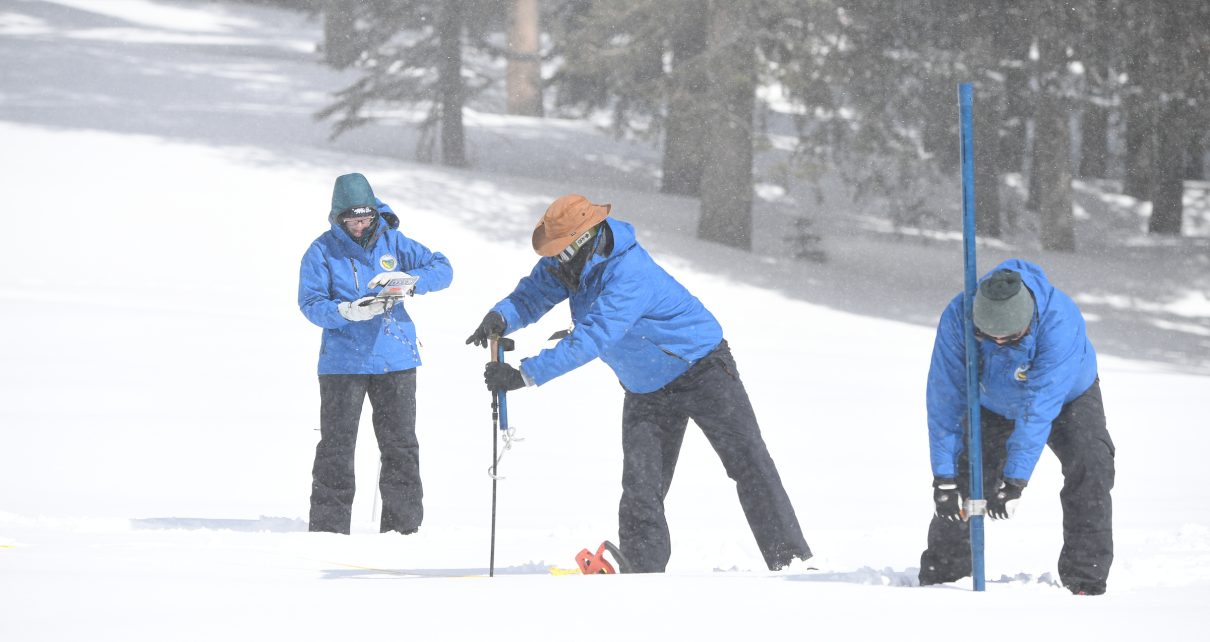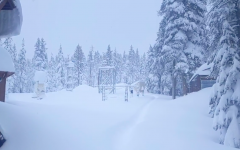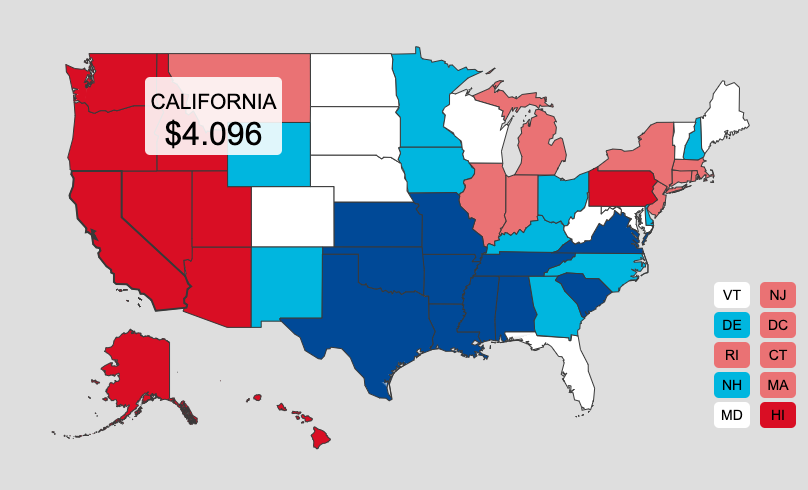
DWR staff conduct the fourth snow survey of the season at Phillips Station on April 3, 2023. (Photo: water.ca.gov)
California Reaches 237% On Average Snowpack Level On Critical April 1st Measuring Date
2023 brings largest snowpack amount since 1952
By Evan Symon, April 4, 2023 2:36 am
The California Department of Water Resources announced that the April 1st snow survey at Phillips Station, widely regarded as the most crucial snow measuring day of the year, was at 221% of average snowpack at the location, with statewide averages coming even higher at 237% of average snowpack.
Before the storms came in late last year, California was still in severe drought statewide. Reservoirs across the state were at under 30% capacity. Snowpack levels are expected to top out now at more than 160%, before dropping significantly down to under 50% by April 1st like previous years. Weather experts predicted that while the drought would be eased somewhat in the Spring, that California would still be at mega-drought levels.
However, those projections have been radically altered by the near constant storms that have hit California since January. That month, snowpack levels in the mountains were at 174% the average amount. In early March, levels were above 200%. Based on measurements Thursday, the average snowpack level statewide was at 227%. In the Southern Sierra Range, a main feeder for both the Central Valley and the Los Angeles area, levels were approaching 300%, with snowpack at 283%. So much has fallen that many ski areas have extended ski season until early July due to the sheer amount of snow. Along with snowpack, reservoir levels across the state have been rapidly approaching full levels as well.
While all snow measuring days are important, especially since they can help estimate how much water will melt down throughout the year and what future flood risks can be like, the April 1st measuring is regarded as the most important. Snowpack levels need to be at at least 100% on April 1st to ensure enough water reaches both urban areas and farms for the rest of the year. That much snow pack can also ensure that California will escape drought-like conditions for the rest of the year, or at the very least, evade mega drought conditions that have stung the state for years. Last year, the April 1st survey found only 38% of average snowpack in California, helping contribute to one of the worst droughts on record in the Golden state.
However, thanks to the over 1 dozen atmospheric storms during the winter, things rapidly turned around this year. According to the 2023 April 1st survey, the DWR recorded 126.5 inches of snow depth and a snow water equivalent of 54 inches, or about 221% on average. DWR’s electronic readings from 130 snow sensors placed throughout the state indicate the statewide snowpack’s snow water equivalent is 61.1 inches, or 237 percent of average for this date.
While officials said that drought would likely be averted for the state for the year, they also said acknowledged that storm damage and flooding has replaced it as the emergency for this year.
“This year’s severe storms and flooding is the latest example that California’s climate is becoming more extreme,” said DWR Director Karla Nemeth on Monday. “After the driest three years on record and devastating drought impacts to communities across the state, DWR has rapidly shifted to flood response and forecasting for the upcoming snowmelt. We have provided flood assistance to many communities who just a few months ago were facing severe drought impacts.”
2023 brought largest snowpack percentage since 1952
The last time Californian snowpack reached 237% was in 1952, with the only dates since WWII hitting above the 200% mark by April 1st being 1952, 1969, and 1983. Due to how much snow has fallen, the DWR will also be giving a rare May snowpack measurement next month. May readings are rare given that most, if not all, snow has melted by then.
“This year’s result will go down as one of the largest snowpack years on record in California,” noted Sean de Guzman, manager of DWR’s Snow Surveys and Water Supply Forecasting Unit, in a statement. “While 1952’s snow course measurements showed a similar result, there were fewer snow courses at that time, making it difficult to compare to today’s results. Because additional snow courses were added over the years, it is difficult to compare results accurately across the decades with precision, but this year’s snowpack is definitely one of the biggest the state has seen since the 1950s.”
For water experts, the large amount of snow and water has proven to be both a blessing and a challenge for this year.
“The good news is that we’ll have an ample amount of water coming down no problem,” explained Jack Wesley, a water systems consultant for farms and multi-family homes. “The problem comes to as where to put it. We can fill in any space in reservoirs now, maybe give some of those big releases that environmentalists are so fond of, but we may still have a bit of a water problem. I mean, long extinct lakes are popping up again now, so we’ll need a plan on where all this meltwater is to go. We need to save as much as possible, but at the same time, we don’t want or need any more flooding.”
More snowpack measurements are expected next month for the first time in years.
- Bill to Require Law Enforcement Disclosure if AI Was Used To Help Write Reports - August 7, 2025
- Gov. Newsom Files FOIA Request To ‘Expose True Cost’ Of L.A. Federal Troop Deployment for Anti-ICE Riots - August 6, 2025
- California Redistricting: How Newsom’s Plan Will Demolish Hard Fought GOP Gains - August 6, 2025




I wanted to give, what was given to me; snow in Tahoe before Thanksgiving and lakes, especially Shasta Lake near capacity for waterskiing.
52-50
Suck on THIS, Newsom… (and don’t you DARE drain the reservoirs…we are watching you like HAWKS)
Democrats will drain it – “for the fish” as the excuse.
They want to keep that Drought TAX going.
I am still awaiting for the 4 or 5 times voting passed for more water storage to happen – I bet they throw another one in there again just to tax us more.
Since the last draught/rain system in the 90’s, California constructed zero additional water storage presumably because infrastructure spending takes away from welfare spending. So here we are, full circle, just as puzzled. The country as a whole has lost it’s mojo. California is just the most obvious because we are closest to it.